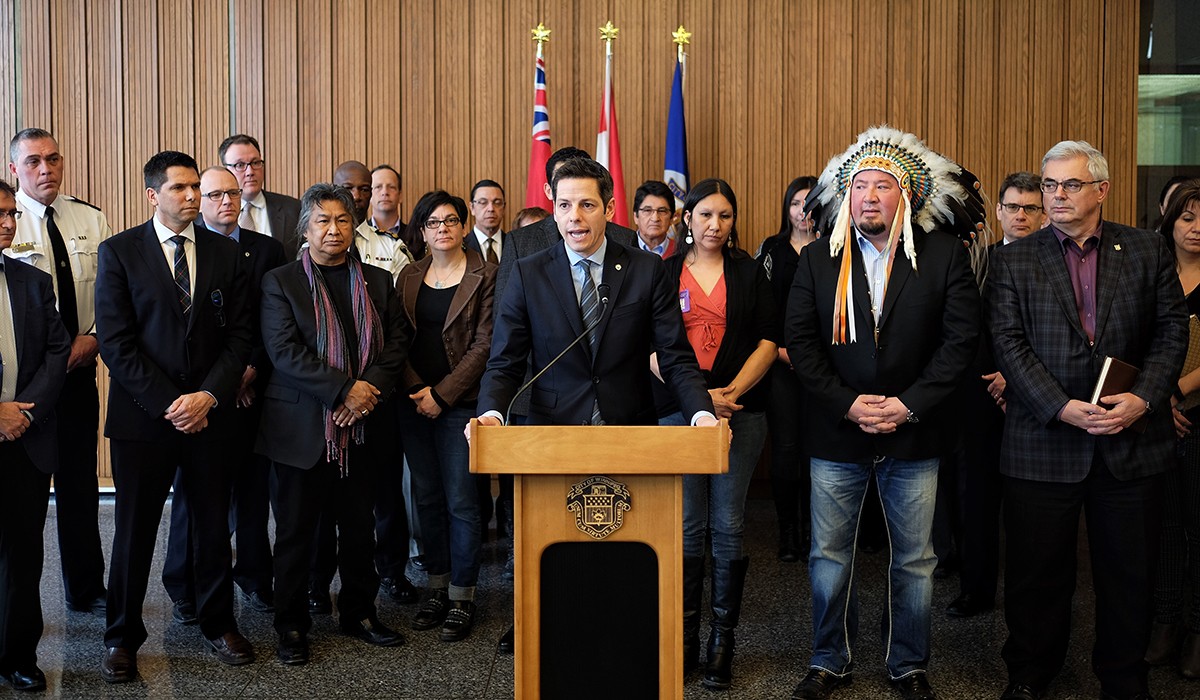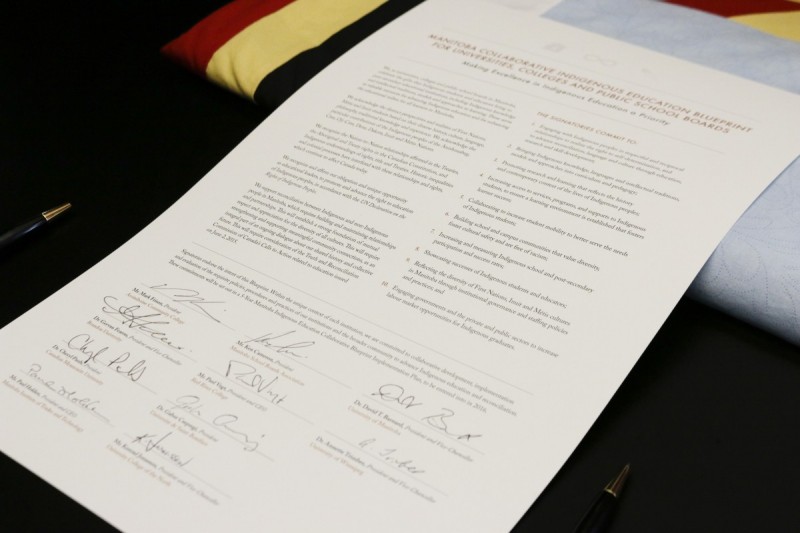
One year ago David Barnard went to city hall to stand with Mayor Brian Bowman as he vowed to confront issues of racism head on. // Photo: Mike Deal, Winnipeg Free Press
‘There’s much still to be done. But we’re on the right path.’
One year ago Maclean’s magazine declared Winnipeg Canada’s most racist city.
Swiftly, community leaders, including University of Manitoba President David Barnard, gathered at City Hall and stood with Mayor Brian Bowman [BA/96] as he vowed to confront issues of racism head on. Our city’s Indigenous and civic leaders said they would enact meaningful, robust, and permanent change to our systems and cultures; the status quo would be challenged.
Today the mayor once again gathered community leaders at City Hall to update the city on the progress. Reflecting on this day, and the 364 prior, President David Barnard said:
One thing the focus on racism in our city over the past year has demonstrated is that this is a community that doesn’t hide from its flaws, that doesn’t slip its problems under the carpet. When Mayor Bowman called me and others to his news conference last year, we dropped whatever we were doing, on short notice, because we all knew it was important that we stand together to confront the truth. The original Maclean’s article may or may not have been entirely accurate, but it spurred a conversation that this community needed to have. And many of us as leaders in the community knew we needed to be part of that conversation. We wanted to be part of that conversation.
At the University of Manitoba we’ve been committed to addressing issues of racism for many years, as well as issues related specifically to how we can be more reflective as an institution of Indigenous peoples and ways of knowing, so that ultimately the University of Manitoba is more welcoming to Indigenous students, faculty and staff. In the last year in particular I think we’ve made real headway. There’s much still to be done. But we’re on the right path.
As President Barnard wrote in Maclean’s last year, its jolting article did not alter our university’s behaviour: we were already committed to making this a more mutually accepting society.
What did change a year ago was the mayor publicly declaring his commitment to fostering changes. This has helped facilitate the U of M’s endeavours, but there is still much to be done at this institution, says the acting head of the department of Native studies.
“The Maclean’s article was a recognition of what Indigenous peoples in this city have known for over a century but it woke up a large segment of the non-Indigenous population of this city and that is a good thing,” says Niigaanwewidam James Sinclair, associate professor and acting head of the department of Native studies. “Will, however, needs action, and while there has been incremental change in Winnipeg, it will take a much longer and sustained effort to reduce the racism that plagues this community.”

Every post-secondary institute in Manitoba, as well as the Manitoba School Boards Association, met in Migizii Agamik – Bald Eagle Lodge on Dec. 18 to sign the Indigenous Education Blueprint.
Sinclair notes that although the U of M has made dramatic investments in non-academic supports for Indigenous students, the university needs to direct more funds to academic programming and faculty resources to support its goal of being a centre of excellence for Indigenous scholarship.
On this end, the university is developing a long-term plan on how best to address these specific academic needs, and broader needs such as decolonizing and Indigenizing curricula throughout the university, says Deborah Young, executive lead of Indigenous achievement at the U of M.
In the past year, three momentous events have taken place at the University of Manitoba: the National Centre for Truth and Reconciliation opened, the U of M signed a MOU with the Treaty Relations Commission of Manitoba, and the U of M lead the collaborative effort to construct the Indigenous Education Blueprint, which was signed by all parties of Manitoba’s education sector on Dec. 18. (The U of M also unveiled its $500-million Front and Centre campaign, a pillar of which involves making Manitoba a centre of excellence for Indigenous education and research.)
The Indigenous Education Blueprint continues to be discussed in our community as stakeholders weigh in on how it should be used: what is the best way for a university to incorporate Indigenous perspectives into its learning environment?
This crucial question is a focus of Indigenous Awareness Week at the University of Manitoba, which runs from Jan. 25-29.
 Join us at Indigenous Awareness Week as we continue to discuss the role of this university in bridging the gap between Indigenous and non-Indigenous peoples, and making this a mutually accepting society. There is much more work to be done, and as the mayor demonstrates, we must come together to do it.
Join us at Indigenous Awareness Week as we continue to discuss the role of this university in bridging the gap between Indigenous and non-Indigenous peoples, and making this a mutually accepting society. There is much more work to be done, and as the mayor demonstrates, we must come together to do it.







Maybe we should buy Nancy Macdonald and those who share her view of this One Great City a mirror so they can look at true racists every day.
I am a German immigrant who came to Winnipeg in 1962. After 30 years of teaching Math and Science in Wpg. public schools I can assure you that Winnipeg is one of the most friendly and welcoming city in the world. I have seen many cities in many countries.
I have three Great-grandchildren who are French-Canadian and Metis. I am proud of them.
I know that Winnipeg is not and has never been a racist city. The racist label is untrue and insulting all the helpful, friendly,tolerant and hard working citizens of this “One Great City”.